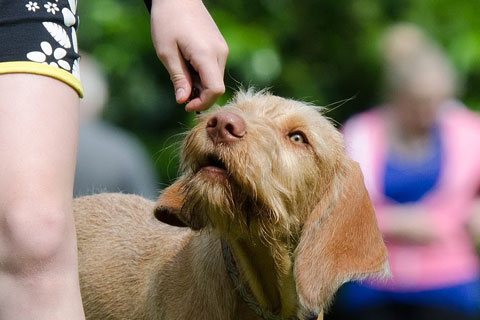Anyone out there that has baked bread has heard of proofing your dough. It is the final step of allowing the shaped dough to rise before baking. Proofing is also a term that is used in dog training and much like in baking, proofing is one of the final steps before completing the training process. Proofing your dog’s behavior is simply a fancy way of saying that you are teaching your dog to perform a certain command (or act in a certain way) regardless of the situation. In my experience many dog owners do a great job of teaching their dog a command, but do not spend enough time on the final training step, proofing the command. All dog owners have goals in mind for their pet, even if they don’t think of them as training goals. A great example is when an owner asks a dog to come in from outside. What the owner does not realize is that there are many distractions for the dog outside and if they have not proofed the come command around distractions it is unlikely that the dog will perform the command, even if they already know what come means.
It is much easier to understand how proofing works if you think about it in the context of one command at a time. In this article we will focus on the come command. The first step in training your dog to come when called is to teach your dog what come means. At Suburban K9 we generally train dogs to run to us and sit facing us when they hear the come command. This means that we teach and master the sit command before teaching come. When we begin teaching the dog how to come when called we start in a very calm environment without distractions. We teach inside without a lot of other dogs or people around so that the dog can focus his entire brain on the task at hand. This process can take anywhere from a few minutes to a few days depending on the dog. It is important to ensure that the dog fully understands the command before moving on.
After teaching your dog the come command it would be easy to put on a show and impress your friends and family with how great he is doing. Simply take your dog to his “training room” eliminate all the distractions and show off his skills at coming when called. But what happens if you take the dog to your friend’s house to show off his new command? There is a very real chance that your dog will either stare at you blankly or be too distracted by all the exciting things around him in order to properly listen to his command. This is why we must proof the command!
Proofing the come command can seem daunting at first, but it is much easier when you consider it a series of small manageable exercises rather than one large task. Create a list of locations where you want your dog to listen and common distractions you want him to be able to ignore when needed. When making the list don’t forget the obvious; your front and back yard, different rooms of the house, and your garage. You should also include some more difficult places the dog might encounter; your parents’ house, a grassy field, a store parking lot, and around your neighborhood. In terms of distractions you’ll probably want him to listen when he sees another dog, a cat, a squirrel, an adult, a child, a person on a bike, food, toys etc.
After compiling your list simply start training in the easiest location or with the easiest distraction. Once a dog has learned the come command well, we use a long training leash (20-150 feet) while proofing. When proofing, train until your dog is able to perform the come command in a certain situation and then move on to the next item on your list. If a distraction or situation feels too hard for the dog, just decrease the distraction level. You can move to an area with slightly less distractions or just try and move the distractions a little farther away. It is important not to train too much in one day. The amount of training time depends on the dog’s breed, personality and age. We generally train for about an hour and a half per day (broken into smaller chunks) with an adult dog.
Just as proofing is an essential part of baking, proofing is also essential in order to have a fully trained dog. Even if you don’t plan on ever letting your dog off leash in a non-fenced area, he will probably get loose at some point in time. A dog who has had his come command proofed is much less likely to run off and get lost or hurt. It would take a full book to cover all the additional questions that may arise after reading this article, but hopefully this is enough to get you excited and point you in the right direction.




 WSHS can accept credit-card donations online using a secure server. Click on the Donate Now button. You can choose how your donation will be used! All donations are tax deductible.
WSHS can accept credit-card donations online using a secure server. Click on the Donate Now button. You can choose how your donation will be used! All donations are tax deductible.